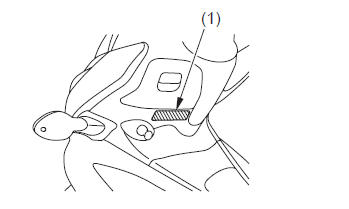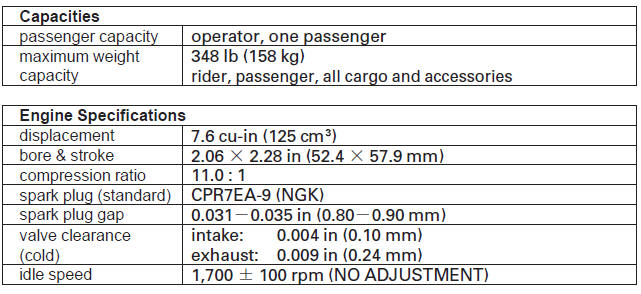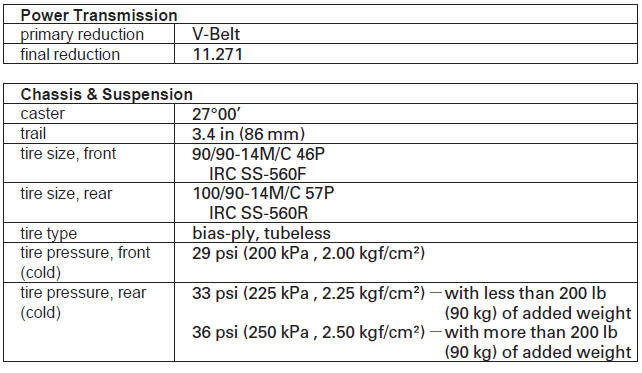 Honda PCX125 - Owner's Manual > Technical Information
Honda PCX125 - Owner's Manual > Technical Information
Vehicle Identification
Serial Numbers
The VIN and engine serial number are required when you register your scooter.
They may also be required when ordering replacement parts. You may record these numbers in the Quick Reference section at the rear of this manual.
The VIN (vehicle identification number) is stamped on the frame body under the seat and also appears on the Safety Certification Label attached inside the leg shield.
INSIDE LEG SHIELD

- VIN
UNDER SEAT

- VIN
The engine number (3) is stamped on the left side of the crankcase near the rear wheel.
LEFT SIDE

- engine number
Color Label & Code
The color label is located in the center compartment. Open the seat to check the label.
The color code is helpful when ordering replacement parts. You may record the color and code in the Quick Reference section at the rear of this manual.
CENTER COMPARTMENT

- color label
Specifications






Break-in Guidelines
Help assure your scooter's future reliability and performance by paying extra attention to how you ride during the first 300 miles (500 km).
During this period, avoid full-throttle starts and rapid acceleration.
Emission Control Systems
Exhaust Emission Requirements
The U. S. Environmental Protection Agency (EPA) and the California Air Resources Board (CARB) require that your scooter comply with applicable exhaust emissions standards during its useful life, when operated and maintained according to the instructions provided.
The Vehicle Emission Control Information label (1) is attached to the inside of the center compartment.
UNDER SEAT

- vehicle emission control information label
Noise Emission Requirements
The EPA also requires that scooters built after January 1, 1983 comply with applicable noise emission standards for one year or 3,730 miles (6,000 km) after the time of sale to the ultimate purchaser, when operated and maintained according to the instructions provided.
Warranty Compliance
Compliance with the terms of the Distributor's Warranties for Honda Scooter Emission Control Systems is necessary in order to keep the emissions system warranty in effect.
Source of Exhaust Emissions
The combustion process produces carbon monoxide (CO), oxides of nitrogen (NOx), and hydrocarbons (HC). Control of hydrocarbons and oxides of nitrogen is very important because, under certain conditions, they react to form photochemical smog when subjected to sunlight. Carbon monoxide does not react in the same way, but it is toxic.
Honda Motor Co., Ltd. utilizes various systems to reduce hydrocarbons, oxides of nitrogen, and carbon monoxide.
Exhaust Emission Control System
The exhaust emission control system includes an ignition timing control system, a PGM-FI system, a three-way catalytic converter, and an oxygen sensor.
No adjustment to these systems should be made although periodic inspection of the components is recommended.
Programmed Fuel Injection (PGM-FI) System
The PGM-FI system has four subsystems: Air Intake, Engine Control, Fuel Control, and Exhaust Control.
The Engine Control Module (ECM) uses various sensors to determine how much air is going into the engine. It then controls how much fuel is injected under all operating conditions.
Ignition Timing Control System
The system constantly adjusts the ignition timing, reducing the amount of HC, CO and NOx produced.
Three-Way Catalytic Converter
The three-way catalytic converter is in the exhaust system. Through chemical reactions, they convert HC, CO, and NOx in the engine's exhaust to carbon dioxide (CO2), dinitrogen (N2), and water vapor.
Evaporative Emission Control System
This scooter complies with the requirements of the California Air Resources Board (CARB) evaporative emission regulations. Fuel vapor from the fuel tank is directed into the charcoal canister and air cleaner where it is adsorbed and stored while the engine is stopped. When the engine is running and the purge control solenoid valve is open, fuel vapor in the charcoal canister and air cleaner is drawn into the engine through the throttle body.
Crankcase Emission Control System
The engine is equipped with a closed crankcase system to prevent discharging crankcase emissions into the atmosphere.
Blow-by gas is returned to the combustion chamber through the air cleaner and the intake manifold.
Problems That May Affect Scooter Exhaust Emissions
If you are aware of any of the following symptoms, have the vehicle inspected and repaired by your authorized Honda scooter dealer.
Symptoms:
- Hard starting or stalling after starting
- Rough idle
- Misfiring or backfiring during acceleration
- After-burning (backfiring)
- Poor performance (driveability) and poor fuel economy
Noise Emission Control System
TAMPERING WITH THE NOISE CONTROL SYSTEM IS PROHIBITED: U. S. federal law prohibits the following acts or the causing thereof: (1) The removal or rendering inoperative by any person, other than for purposes of maintenance, repair or replacement, of any device or element of design incorporated into any new vehicle for the purpose of noise control prior to its sale or delivery to the ultimate purchaser or while it is in use; or (2) the use of the vehicle after such device or element of design has been removed or rendered inoperative by any person.
AMONG THOSE ACTS PRESUMED TO CONSTITUTE TAMPERING ARE THE FOLLOWING ACTS:
1. Removal of, or puncturing the muffler, baffles, header pipes or any other component which conducts exhaust gases.
2. Removal of, or puncturing of any part of the intake system.
3. Lack of proper maintenance.
4. Replacing any moving parts of the vehicle, or parts of the exhaust or intake system, with parts other than those specified by the manufacturer.
Fuel Permeation Emission Control System
This vehicle complies with the Fuel Permeation Emission Control regulations of the U.S. Environmental Protection Agency (EPA) and the California Air Resources Board (CARB). The fuel tank, fuel hoses, and fuel vapor charge hoses used on this vehicle incorporate fuel permeation control technologies.
Tampering with the fuel tank, fuel hoses, or fuel vapor charge hoses to reduce or defeat the effectiveness of the fuel permeation technologies is prohibited by federal regulations.
Catalytic Converter
This scooter is equipped with a three-way catalytic converter.
The catalytic converter contains precious metals that serve as catalysts, promoting chemical reactions to convert the exhaust gasses without affecting the metals.
The catalytic converter acts on HC, CO, and NOx. A replacement unit must be an original Honda part or its equivalent.
The catalytic converter must operate at a high temperature for the chemical reactions to take place. It can set fire to any combustible materials that come near it. Park your scooter away from high grasses, dry leaves, or other flammables.
A defective catalytic converter contributes to air pollution, and can impair your engine's performance. Follow these guidelines to protect your scooter's catalytic converter.
- Always use unleaded gasoline. Even a small amount of leaded gasoline can contaminate the catalyst metals, making the catalytic converter ineffective.
- Keep the engine in good running condition. A poorly running engine can cause the catalytic converter to overheat causing damage to the converter or the scooter.
- If your engine is misfiring, backfiring, stalling, or otherwise not running properly, stop riding and turn off the engine. Have your scooter serviced as soon as possible.
Oxygenated Fuels
Some conventional gasolines are being blended with alcohol or an ether compound. These gasolines are collectively referred to as oxygenated fuels. To meet clean air standards, some areas of the United States use oxygenated fuels to help reduce emissions.
If you use an oxygenated fuel, be sure it is unleaded and meets the minimum octane rating requirement.
Before using an oxygenated fuel, try to confirm the fuel's contents. Some states/ provinces require this information to be posted on the pump.
The following are the EPA-approved percentages of oxygenates:
ETHANOL (ethyl or grain alcohol) 10% by Volume
You may use gasoline containing up to 10% ethanol by volume. Gasoline containing ethanol may be marketed under the name ''Gasohol''.
MTBE (Methyl Tertiary Butyl Ether) 15% by Volume
You may use gasoline containing up to 15% MTBE by volume.
METHANOL (methyl or wood alcohol) 5% by Volume
You may use gasoline containing methanol containing up to 5% methanol by volume as long as it also contains cosolvents and corrosion inhibitors to protect the fuel system. Gasoline containing more than 5% methanol by volume may cause starting and/or performance problems. It may also damage metal, rubber, and plastic parts of your fuel system.
If you notice any undesirable operating symptoms, try another service station or switch to another brand of gasoline.
Fuel system damage or performance problems resulting from the use of an oxygenated fuel containing more than the percentages of oxygenates mentioned above are not covered under warranty.
Oxygenated fuels can damage paint and plastic. Be careful not to spill fuel when filling the fuel tank. Wipe up any spills immediately.

Oxygenated fuels can damage paint and plastic. Damage caused by spilled fuel is not covered by warranty.
See also:
 Honda PCX125 - Owner's Manual > If a Fuse Blows
Honda PCX125 - Owner's Manual > If a Fuse Blows
All of the electrical circuits on your scooter have fuses to protect them from damage caused by excess current flow (short circuit or overload). If something electrical on your scooter stops working, the first thing you should check for is a blown fuse.
 Rider's Manual BMW R 1250 GS GSA
Rider's Manual BMW R 1250 GS GSA Owner's Manual Harley-Davidson Sportster XL1200X Forty-Eight
Owner's Manual Harley-Davidson Sportster XL1200X Forty-Eight Owner's Manual Honda CBR650R
Owner's Manual Honda CBR650R Service manual Honda CBR650
Service manual Honda CBR650 Owner's Manual Honda PCX125
Owner's Manual Honda PCX125 Owner's Manual Kawasaki Z1000SX
Owner's Manual Kawasaki Z1000SX Service manual Kawasaki Z1000SX
Service manual Kawasaki Z1000SX Owner's Manual Lexmoto Echo
Owner's Manual Lexmoto Echo Owner's Manual Royal Enfield Interceptor 650
Owner's Manual Royal Enfield Interceptor 650 Service manual Royal Enfield Interceptor 650
Service manual Royal Enfield Interceptor 650 Owner's Manual Yamaha MT-07
Owner's Manual Yamaha MT-07